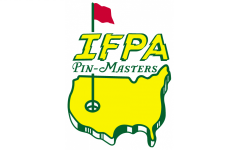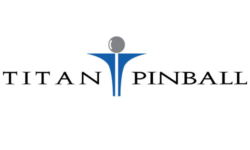The World Pinball Player Rankings, created by the International Flipper Pinball Association, are updated upon the completion of any IFPA sanctioned tournament. All IFPA sanctioned events from around the world are eligible for World Pinball Player Rankings Points which are awarded according to the tournament’s strength of field, number of participants, format of the tournament, and the players’ finishing position.
At the end of the calendar year, the player with the most WPPR points will be crowned the ‘World’s Greatest Pinball Player’ for that particular year.
The way WPPR points have been calculated and distributed has changed since the creation of the WPPR system in 2006. The latest modification to the formula is being made for the 2024 season, which will be running WPPR version 6.0. Anytime a change is made to the WPPR formula, we generally receive some common questions. Please see our FAQ page for more information, or read the details of the current WPPR system below:
Translations available in:
Table of Contents
– Overview of Changes for 2024 (v6.0)
– Defining League vs. Tournament play
– Tournament Value Adjustment (TVA)
– Tournament Grading Percentage (TGP)
Overview of Changes for 2024 (v6.0)
- Creation of the “WPPR PRO” rankings
- This ranking will analyze to what extent the results making up that player’s ranking are a representative sample of all the active results over the past 3 years on that player’s profile. To the extent that it is representative, your relative rank will go up. To the extent that it is not representative, your relative rank will go down. More details on the “WPPR PRO” formula can be found HERE.
- The “WPPR PRO” rankings will list the top 250 players ranked in the ‘Main’ system after this v6.0 adjustment is made and the top 100 players ranked in ‘Women’s’ system after this v6.0 adjustment is made.
- The “WPPR PRO” rankings will be the metric that is officially used for IFPA World Pinball Championship qualifying and seeding, along with who we crown as the “World’s Greatest Pinball Player” for finishing in the #1 spot.
- Reduction in the number of events that count towards a player’s world ranking.
- Reduced from 20 events down to 15 events.
- IFPA North American Championship Series will remain at 20 events counting in those standings.
- Dynamic portion of the WPPR Point Distribution formula will be changing. The dynamic distribution will stretch to anyone that finishes in the top half of the field regardless of the number of players at the event (previously this was capped at the top 64 players for any events with more than 128 participants).
- The IFPA will be implementing a $1 sanctioning fee for Women’s events in North America starting in 2024.
- Update to eligibility requirements for events to grade out to >100%
- Previously the finals format must include an elimination format that includes a minimum of 10% of the participants to be eligible. This elimination format must include a round where a maximum of 4 players remain. We are adding the requirement that any meaningful tiebreakers to either receive a bye, advance to finals or advance through rounds within finals cannot be done through an automatic tiebreaking process. These tiebreakers must be played out. Any kind of scoring system seen as trying to circumvent this rule (for example, ‘710/501/300/100’ instead of ‘7/5/3/1’ will result in the event having a maximum value of 100% TGP.
- Any players currently playing their turn in another match at the same location cannot be penalized as absent for the other concurrent events. This only applies to concurrent events that both have direct play formats.
- Tournaments that run an UNLIMITED Card qualifying format with a minimum 20 hours of qualifying time, will have those qualifying games counted at 4X value (16% increase to TGP for each game included in the qualifying standings). Unlimited Best Game qualifying format with a minimum 20 hours of qualifying time will continue to have those qualifying games counted at 2X value.
- Updated rules verbiage for removing available games during an event – Most commonly done in an effort to speed an event up, we have seen TD’s increase the usage of Classics machines as an event progresses as Classics machines often finish quicker than Modern machines. The IFPA expects TD’s to maintain consistency throughout the entire event with respect to the types of machines that are available to be played. Any efforts made to alter the game availability list anytime during an event in such a way that it materially changes the mix of machines that was present at the start of the event will no longer earn TGP after the point at which this change is made. For example, having an event that requires players to play Modern and Classics machines, which then materially decreases or eliminates the amount in which Modern (or Classics) machines are used at some point in the event would trigger this rule. Please contact the IFPA if you have any questions regarding how this rule impacts your event.
- All participants of an IFPA sanctioned league or tournament must have a chance to win the highest division available if they want to be included in the results submitted to IFPA. Any players that do not have an opportunity to win based on external factors of the format/groupings of that league or tournament should not have these players included in the results submitted to IFPA. Additionally, assigning divisional placement amongst a field of competitors by something other than total points earned across that entire field of competitors will not be allowed unless approved by the IFPA in advance.
- Ladder leagues that assign divisions based on groupings rather than total points must use an initial seeding process that is based on some kind of open play process or through random seeding. Ladder leagues cannot use any external or past data to seed players due to the handicapped nature of the format.
- Update to Country Championship Series Final rules:
- Only IFPA registered players are eligible to compete
- Only players which earned qualifying points within the series are eligible to compete
- A maximum of 64 players are allowed to compete
In determining the World Pinball Player Rankings, several basic rules were put into place to meet the needs and goals of the IFPA, tournament directors and for the players themselves.
- All IFPA sanctioned tournaments and leagues are eligible for WPPR points, with each player’s top 15 active events counting towards a player’s world ranking. The value of each tournament will be calculated based on a few variables that we will go into detail about below.
- Five tournaments will receive an Event Booster of 200% of the calculated tournament value. We consider these tournaments the “Major Championships” of competitive pinball. These tournaments are: IFPA World Pinball Championship, PAPA World Pinball Championships, Pinburgh Match Play Championships, European Pinball Championships and The Open. IFPA Championship Series and IFPA Certified+ events will receive an Event Booster of 150%. IFPA Certified events will receive an Event Booster of 125%. Details regarding Certification can be found in the “EVENT BOOSTER” section below.
- Every tournament and/or league event submitted will be individually calculated, graded and listed on a player’s resume. For example a monthly tournament will show as 12 individually listed tournaments on a player’s resume. A pinball league that runs 3 seasons per year will be listed as 3 separate listings on a player’s resume for that given year.
- The value of a tournament is calculated from determining a Base Value, a Tournament Value Adjustment (TVA) based on the quality of the players participating, a Tournament Grading Percentage (TGP) based on the quality of the format of the tournament and the application of Event Boosters if any are available. Full details on each of those metrics are available below.
- WPPR points distributed will be factored based on the number of people who competed in the tournament and where a player finishes. For example, a player might get 5 points for finishing 2nd in a 10 player tournament, but get 30 points for finishing 2nd in a 50 player tournament.
- The WPPR System will weigh recent results over historical results. Points earned over the last year are worth 100% of their value. Events one to two years old are worth 75% of their original value. Events two to three years old are worth 50% of their value. Any event over three years old is reduced to zero value.
- Many events run ‘side tournaments’ that are run in conjunction of the main tournament (Classics tournaments are the most popular example). These will be graded individually like all other tournaments, and will be listed on a player’s resume as a separate event.
- Only open tournaments are included in the WPPR system. However, depending on circumstances, exceptions can be made.
- IFPA will not sanction events with less than 3 players. We also require that a single winner is determined for results to be accepted.
- IFPA will not sanction team events. Only individual events are eligible to be sanctioned.
- All tournaments are required to have a publicly available website/Facebook event or group that has relevant information such as the contact information for the tournament director, and information about the event itself.
- IFPA sanctioned tournament directors will be responsible for communicating the format details of their tournament in the IFPA calendar submission process, and responsible for verifying that format during the results submission process to help ensure an accurate calculation of the TGP.
- Please note that the IFPA/PAPA rules regarding gambling are in effect for all IFPA sanctioned events. This includes IFPA sanctioned events that don’t incorporate the IFPA/PAPA ruleset as part of their tournament rules. Please visit Section III, Paragraph 7 for those details HERE.
- There are no limitations to how many events any particular location or organizer can hold. For any tournaments submitted to the IFPA calendar as ‘private’ (address not listed publicly on our site), the IFPA requires a minimum of 16 players to attend for that tournament to be sanctioned for WPPR points. The IFPA now requires a full address in the calendar submission, and it is understandable for tournament directors to want to host IFPA sanctioned tournaments out of their homes and not have their full address made public. Any private tournament that fails to reach 16 players will not be sanctioned for WPPR points. An organizer is limited to hosting 4 ‘private’ tournaments per year for a given location. This rule does not apply to Women’s-only events.
- For any IFPA sanctioned tournament or league, players can only be included in IFPA final results if they have met at least 50% of all qualifying requirements. Any players that don’t meet this minimum participation requirement should be removed from the results by the tournament director (TD) prior to submitting those results to the IFPA. This rule does not apply for any players ranked in the top 250 going into the event. For example, a Best Game qualifying format where 10 machines are available with the best 7 scores counting towards the player’s qualifying position, any player that plays fewer than 4 machines will be removed from the standings submitted to the IFPA. For Direct Play events with no “finals” the entire tournament will be considered part of the qualifying requirements. Players that advance to the final round despite not meeting this percentage may also be included in the final standings submitted to the IFPA. Please note for Top 250 players, playing but voiding in any format that allows it will have you placed in last place for IFPA submission purposes.
- For any IFPA sanctioned league, players must participate in at least 50% of the actual number of sessions of the regular season to be included in the final standings submitted to the IFPA. Please note that if a league holds 8 sessions but only the best 6 sessions count towards the standings of that league, a player must participate in at least 4 sessions to be included in the results submitted into the IFPA.
- Certain formats (Selfie Leagues, TOPS Tournaments, etc) rely on players submitting their own results without the verification of a TD or authorized scorekeeper on site. Any qualifying format that includes “unverified” results where a TD, league official, or authorized scorekeeper is not present to record their score, will not have the qualifying portion included in the TGP calculation. The IFPA will classify these qualifying formats as strictly for seeding purposes, with only the finals format counting towards the TGP calculation. Only players that participate in the Final of these events will be eligible to be included in the results submitted to the IFPA.
- The IFPA is launching the IFPA Tour of sanctioned Pin-Golf events. We are now enforcing stricter rules regarding how organizers can score an IFPA sanctioned Pin-Golf format event, and events must meet this criteria with their course design to award WPPR points as an IFPA sanctioned event. The WPPR points awarded for Pin-Golf events will now include a Pin-Golf Multiplier (PGM) adjustment. This metric is used to grade the difficulty of the course. Full details on the IFPA Tour, rules of course design, and the calculation of the PGM adjustment are available HERE.
- Only Rated players will be included in the player count with respect to base value. A player becomes Rated after participating in 5 events lifetime. These unrated players will still be able to earn WPPR points, and impact the distribution of the points from a tournament, but they simply won’t be counted towards the 1/2 point per player count for the base. This is to limit the impact of organizers trying to sign up random participants, or worse, list fake names of players that did not participate as a way to artificially increase the base value of the tournament.
- We have put a rule in place that you can only play a maximum of 3 meaningful games per machine per ‘state/round’ of an event. Organizers with only one machine are welcome to do multiple rounds or stages where players are eliminated in the process and be able to capture more meaningful games played, but the ‘high score tournament’ or average score, etc. with X number of games counting maxes at 3 per physical machine.
- For any tournaments that have multiple paths of qualifying for the finals, we will take the SHORTEST of those paths when counting meaningful games played for that portion of the tournament. This is to try and stop the confusing formats where organizers offer a way for players to qualify for an event easily, and then have some subgroup of players also battling out for spots by using a longer process, while being able to capture the games played for that subgroup of players. Couple of examples would be taking having 5 machines and allowing the high score of each machine a spot in the finals, while also giving players a chance to advance to the finals based on their play across all 5 machines. This would now count as ONE meaningful game played because of that potential path for players to reach the finals rather than 5.
- For any brackets, we want to promote tournaments using a consistent number of games from round to round. For bracket tournaments we have seen organizers use single game matches throughout, only to then backload the number of games played by having the final match be a best of 25 match. We will use the minimum number of games for any one round of play in determining how many meaningful games played get counted, so if someone wants to run best of 3 matches they should be making that choice for the entire bracket. They will no longer be able to pick certain rounds to expand that match total, or rather they could, but they would still only be credited for 3 games played for that round. We are okay with the winner’s bracket and loser’s bracket being different lengths, as long as it’s consistent across each of them individually.
- For any group play rounds, we want to promote tournaments using a consistent number of games from round to round. We’ve seen organizers play 3 games per round, except for the last round they would intentionally play 11 rounds in order to reach the 25 games played metric. We’ve also seen organizers play 3 games per round, except for the last round where they would only play 1 game in the round. We will use the minimum number of games for any one round of play in determining how many meaningful games played get counted, so if someone wants to run group matchplay at 3 games per round, they should be making that choice for the entire final. They will no longer be able to pick certain rounds to expand that match total, or rather they could, but they would still only be credited for the round with the fewest games played applied to every round of the final.
- The TGP will now include games played that are fewer than 3 balls, including timed formats where players are attempting to reach a score or objective as quickly as possible. Any game where it’s possible for the player to finish on the first ball in play, will be calculated at 33% value for TGP purposes. Any games set to 1-ball play will be worth 33% value. Any games set to 2-ball play will be worth 66% value. No games beyond 3 balls will be worth anything above 100% for TGP purposes. For example, if players have a goal of reaching a certain feature in a game as a way of winning that game or match, the fact that it is POSSIBLE for the player to reach that objective on ball 1 means this will count as 1/3rd of a game played towards TGP. The exception to this rule will be the Pin-Golf format, which will have it’s own set of grading rules (see next bullet points). Any game where a TD creates a “runaway score” or taps a player out to end their game before all 3 balls have been played will be worth 1/3rd TGP, regardless of when that occurs during the game being played.
- The IFPA will no longer sanction tournaments that don’t have a DIRECT play component as part of the format. DIRECT play represents multiple players (up to a max of 4) playing against one another on a given game (head-to-head or in a group). Many tournaments use an INDIRECT qualifying system where everyone plays the same game (PAPA style qualifying, Best Game qualifying, Pin-Golf). Those tournaments that use an INDIRECT qualifying system must now run a Finals round that consists of DIRECT play between the finalists to crown the winner. A tournament using an INDIRECT qualifying system must advance a minimum of 10% but no more than 50% of those players to the Final. Examples of tournaments no longer eligible for WPPR points would be simple high score tournaments without finals, or Pin-Golf tournaments where you simply play your round/rounds.
- Originally WPPR v5.0 rules used the longest theoretical path to determine the number of meaningful games used for TGP. This made for situations where the tournament was being given credit for a “longest path” that had an extremely low chance of actually happening. We are changing this to ‘expected value’ for # of rounds played for bracket/strike/match play tournaments. We’ve included a detailed breakdown of a few approved finals formats, and the number of games that should be counted towards the TGP value here: http://www.ifpapinball.com/
tgpguide - Any tournament that requires pre-registration must be submitted to the IFPA Calendar a minimum of 30 days before the pre-registration date. Tournaments and leagues without pre-registration must be submitted to the IFPA Calendar a minimum of 30 days before the event.
- Any event that materially changes the format played compared to the format that was originally submitted will have a maximum TGP value of 100%. For example, if you submit a 4-strike event into us for sanctioning and end up running a format that has a separate qualifying and finals portion, that event would not be eligible to get more than 100% TGP. Please notify us of these format changes ahead of the event and we can update the submission in our system to avoid this issue.
- Any players currently playing their turn in another match at the same location cannot be penalized as absent for the other concurrent events. This only applies to concurrent events that both have direct play formats.
- All participants of an IFPA sanctioned league or tournament must have a chance to win the highest division available if they want to be included in the results submitted to IFPA. Any players that do not have an opportunity to win based on external factors of the format/groupings of that league or tournament should not have these players included in the results submitted to IFPA. Additionally, assigning divisional placement amongst a field of competitors by something other than total points earned across that entire field of competitors will not be allowed unless approved by the IFPA in advance.
- Update to Country Championship Series Final rules:
- Only IFPA registered players are eligible to compete
- Only players which earned qualifying points within the series are eligible to compete
- A maximum of 64 players are allowed to compete
Defining League vs. Tournament Play
The IFPA is more clearly defining the differences between what we consider an sanctioned “IFPA Tournament” and an sanctioned “IFPA League”.
The IFPA will be managing two separate registration processes, one for “Tournaments” and one for “Leagues”. The IFPA Calendar will continue to only display “Tournaments”, while our IFPA Leagues page will show a list of all the active IFPA Leagues and the dates of their current season.
Details clarifying these differences are available HERE.
The base value of a tournament is equal to 0.5 WPPR points per Rated player up to a maximum of 32 max base points for any tournament with 64 or more players participating. For example, a tournament with 11 Rated players will have a base value of 5.5 WPPR points. A player becomes an officially Rated player after participating in 5 IFPA sanctioned events.
Tournament Value Adjustment (TVA)
As we mentioned earlier there are two strength indicators that we use to determine the TVA for an event. This includes a TVA based on player RATING, and a TVA based on player RANKING. These values are added to the base value of an event to determine the 1st place WPPR point value for that tournament. The TVA takes into account the best 64 players participating in a tournament for each strength indicator. For the RATING strength indicator, the top 64 RATED players are taken into account. For the RANKING strength indicator, the top 64 RANKED players are taken into account.
- RATING FORMULA
The TVA based on RATING can be worth up to 25 additional WPPR points for a tournament. The formula used to determine the WPPR value that each player adds to the pot is:
(RATING * .000546875) – .703125
We consider a ‘perfect’ player to be rated 2000, so based on the formula that player would add .39 WPPR points to the value of the tournament. 64 players with a rating of 2000 would amount to a 25 WPPR point increase for that tournament. Any player with a rating of 1285.71 or less will have no impact on the strength of the tournament.
- RANKING FORMULA
The TVA based on RANKING can be worth up to 50 additional WPPR points for a tournament. The formula used to determine the WPPR value that each player adds to the pot is:
ln(RANKING) * – .211675054 + 1.459827968
We consider a ‘perfect’ tournament to include the top 64 ranked players in the world participating. Based on the formula the #1 ranked player in the world would add 1.46 WPPR points to the pot, the #2 ranked player in the world would add 1.31 WPPR points to the pot, etc. In total the top 64 ranked players would equal an additional 50 WPPR points in value for the tournament.
Tournament Grading Percentage (TGP)
Every tournament will have the Base Value + TVA multiplied by the TGP to determine the final 1st place value of the tournament. The TGP will be based on the quality of the format of the event. Both the finals component of a tournament and the qualifying portion of a tournament (if there is one) will be included in the calculation. Tournaments that have unlimited qualifying attempts will be graded slightly different from tournaments that have limited qualifying attempts or no qualifying portion. Please note the Pingolf format now has it’s own unique grading system, available HERE.
Events that do not have a separate Qualifying and Finals format have a maximum TGP value of 100%.
Events that have a separate Qualifying and Finals format now have the ability to grade out to a maximum TGP value of 200%. Please note the Finals format must include an elimination format that includes a minimum of 10% of the participants to be eligible. This elimination format must include a round where a maximum of 4 players remain. Any meaningful tiebreakers to either receive a bye, advance to finals or advance through rounds within finals cannot be done through an automatic tiebreaking process. These tiebreakers must be played out. Any kind of scoring system seen as trying to circumvent this rule (for example, ‘710/501/300/100’ instead of ‘7/5/3/1’ will result in the event having a maximum value of 100% TGP. Previously 25 meaningful games played at 4% each would hit that 100% max. This will now be 50 meaningful games played at 4% each to hit this new 200% max.
Tournaments that run an UNLIMITED Best Game qualifying format with a minimum 20 hours of qualifying time, will have those qualifying games counted at 2X value (8% increase to TGP for each game included in the qualifying standings).
Tournaments that run an UNLIMITED Card qualifying format with a minimum 20 hours of qualifying time, will have those qualifying games counted at 4X value (16% increase to TGP for each game included in the qualifying standings).
The TGP will now include games played that are fewer than 3 balls, including timed formats where players are attempting to reach a score or objective as quickly as possible. Any game where it’s possible for the player to finish on the first ball in play, will be calculated at 33% value for TGP purposes. Any games set to 1-ball play will be worth 33% value. Any games set to 2-ball play will be worth 66% value. No games beyond 3 balls will be worth anything above 100% for TGP purposes. For example, if players have a goal of reaching a certain feature in a game as a way of winning that game or match, the fact that it is POSSIBLE for the player to reach that objective on ball 1 means this will count as 1/3rd of a game played towards TGP. The exception to this rule will be the Pin-Golf format, which will have it’s own set of grading rules.
Flip Frenzy formats, also referred to as Pinball! Pinball! Pinball! format will now be graded based on the (AVERAGE number of matches played / divided by 2) by all players in the field. One-Ball Flip Frenzy formats will be graded based on the AVERAGE number of matches played/ divided by 3).
Most commonly done in an effort to speed an event up, we have seen TD’s increase the usage of Classics machines as an event progresses as Classics machines often finish quicker than Modern machines. The IFPA expects TD’s to maintain consistency throughout the entire event with respect to the types of machines that are available to be played. Any efforts made to alter the game availability list anytime during an event in such a way that it materially changes the mix of machines that was present at the start of the event will no longer earn TGP after the point at which this change is made. For example, having an event that requires players to play Modern and Classics machines, which then materially decreases or eliminates the amount in which Modern (or Classics) machines are used at some point in the event would trigger this rule. Please contact the IFPA if you have any questions regarding how this rule impacts your event.
TGP for Target Match Play qualifying will be based on the average number of games played for all qualifiers.
See the breakdown below:
- FINALS/PLAYOFFS COMPONENT
The TGP will be based on the expected number of meaningful games that the winner of a tournament will play, with 4% added to the TGP for each meaningful game played. A guide to help determine the meaningful games played metric is available HERE.
Formats that utilize PAPA style group finals with 4-player groups will be allowed to count each meaningful game played at 2X. For example, a 3-game round with 4-player groups will now count as 6 additional games added to TGP instead of just 3. This is detailed in the TGP Guide under the “PAPA Style Match Play” approved format. Formats that utilize 3-player groups will be allowed to count each meaningful game played at 1.5X.
Please note that group play formats that utilize the “Multi-Matchplay” style of play (players play in parallel across multiple machines rather than serially in the 4-player matches) do not receive the 2X bonus for 4-player groups, or 1.5X bonus for 3-player groups.
For single elimination bracket tournaments where the length of matches can vary (single game, best of 3, best of 5, etc), we will use round that has the MINIMUM number of games played as the metric to calculate TGP.
For double elimination bracket tournaments where the length of matches can vary (single game, best of 3, best of 5, etc), we will use round that has the MINIMUM number of games played as the metric to calculate TGP. The WINNERS and LOSERS brackets will be looked at separately, so those lengths may vary from one another. The LOSERS bracket must be consistent throughout, and the WINNERS bracket must be consistent throughout, or the MINIMUM will be used.
For Match Play formats, the round with the least number of games will be used to calculate TGP.
- QUALIFYING COMPONENT
The TGP for events that include a qualifying portion with a set amount of attempts, or limited amount of attempts will add an additional 4% to the total TGP for each meaningful game played. A meaningful game is based on the data used to advance a player through the qualifying process. For example, if a player is limited to 30 attempts on a machine, and the tournament is taking the highest score on a machine to advance to the finals, this would count as 1 meaningful game played (not 30). A guide to help determine the meaningful games played metric is available HERE.
Match play formats that consist of 4-player groups will be allowed to count each meaningful game played at 2X. For example, Pinburgh consists of a 4-game round with 4-player groups. This will now count as 8 additional games added to TGP instead of just 4. This is detailed in the TGP Guide under the “Match Play Qualifying” approved format.
For tournaments that offer UNLIMITED qualifying attempts, TGP will be increased by 1% per hour that open qualifying is available for all competitors. Please note that this time component is only available for tournaments with UNLIMITED qualifying attempts, and is limited to a 20% increase in TGP from this time component.
Tournaments that run an UNLIMITED Best Game qualifying format with a minimum 20 hours of qualifying time, will have those qualifying games counted at 2X value (8% increase to TGP for each game included in the qualifying standings).
Tournaments that run an UNLIMITED Card qualifying format with a minimum 20 hours of qualifying time, will have those qualifying games counted at 4X value (16% increase to TGP for each game included in the qualifying standings).
The games played in the qualifying portion of the tournament can be added to the TGP calculation only if that qualifying portion reduces the field of participants by 50% or more. For tournaments where fewer than 50% of the field is removed in the qualifying process, the IFPA considers this ‘seeding’ and will not increase the TGP.
For any given machine used in a tournament, a maximum of 3 meaningful games per machine is allowed per ‘state/round’ of an event. For qualifying purposes this means the maximum number of games counted towards TGP would be 3. For finals purposes it means that a best-of-3 match is the maximum length for that match if only one machine is available.
With the added “Event Booster” metric (Majors/Certified/Etc.), please note that the final value of the tournament will be the TGP X Event Value.
In addition to the TVA and TGP metrics used in determining the overall value of a tournament, the IFPA also has Event Boosters available for tournaments that are either more prestigious in nature or utilize format characteristics that the IFPA feels are of the highest quality.
Please note that the final value of the tournament will be the TGP Value multiplied by the Event Booster Value. The highest possible being a 200% TGP event that is also a Major Championship, which receives an Event Booster of 200%, resulting in 400% as the total value of the event.
Majors –> IFPA World Pinball Championship, PAPA World Pinball Championships, European Pinball Championships, Pinburgh Match Play Championship and THE OPEN will receive an Event Booster value of 200%. Major Championships are not also eligible for the Certification Event Booster.
IFPA Championship Series events –> This classification of event has an Event Booster value of 150%. These events are not also eligible for the Certification Event Booster. This includes the following events:
- Any IFPA Country Championship Series final, Any IFPA State and Provincial Championship final, IFPA North American Pinball Championship, Any IFPA European Championship Series event along with the ECS Final, IFPA Pin-Masters Championship, IFPA Heads-Up Pinball Championship, IFPA Power100 Championship, Stern Pro Circuit Final. Championship Series events that run formats that are Certified will not get any additional boost beyond this 150%.
IFPA Certified+ events –> This classification of event has an Event Booster value of 150%. Certified+ require the following attributes:
- 128 rated player minimum
- Limited Best Game/Card Qualifying- minimum 24 attempts with minimum best 12 games being counted,
minimum 20 hours of qualifying time. - Unlimited Best Game/Card Qualifying – minimum 20 hours of qualifying time, minimum 5 games being counted.
- Match Play Qualifying formats (4-player groups) require minimum of 20 qualifying games.
- Head to head Qualifying formats require minimum of 40 qualifying games.
- 24 finalists minimum (up from 16) – Same finals format requirement as 2022
- No other qualifying formats eligible (Flip Frenzy, Pin-Golf, etc)
- No player may receive a bye beyond the round of 16 finalists.
- Maximum length of the tournament is 4 consecutive days.
- Finals for the top 24 cannot start on the same day that Qualifying starts.
- Finals portion of the tournament must consist of one of the following approved formats: PAPA style match play rounds (minimum of 3 games per round) or IFPA style head-to-head play (minimum best of 5 matches per round). All game choices during finals must be made by the players.
IFPA Certified events –> This classification of event has an Event Booster value of 125%.
- Certified require all of the attributes from the above Certified+ list except for the 128 player minimum (item “a”).
Calculation and distribution of WPPR points for each tournament involves many steps:
- Set an entry ranking for first time players. Currently they are given the same ranking as the 10th percentile ranked person.
- Calculate the Tournament Base Value (per formula above).
- Calculate the TVA based on the RATING strength indicator (per formula above).
- Calculate the TVA based on the RANKING strength indictor (per formula above).
- Calculate the Tournament Grading Percentage (per formula above).
- Using the tournament base value and TVA from the RATING and RANKING strength indicators, multiplied by the TGP, calculate what the WPPR point value is for the tournament winner.
- Two WPPR point distribution values are then calculated for the rest of the field of participants.
One is a linear distribution value based on the number of players in the tournament.
(PlayerCnt + 1 – Finishing Position) * 10/100 * (1st place value / playerCnt)
The second value is a dynamic distribution value using the top half of the players in the field players of a tournament.
(power(( 1 – power((( Finishing Position -1) / min(RatedPlayerCnt/2,64)),.7)),3)) * 90 /100 * (1st place value)
These two values are what a player earns for a given tournament.
To help gauge the skill of a player we have incorporated a ratings system that leverages a players’ finishing order to “simulate” head to head play. This Rating is used as part of the TVA for the RATING strength indicator to help determine the value of each tournament.
- Glicko is being used as the foundation of the ratings system.
- To simulate head to head play, we are using the results of tournaments we already track. We know this isn’t true head to head, but that data is not avaliable.
- For a given player in a tournament, any player finishing ahead of them is treated as a loss and everyone they finish ahead of is treated as a win. Ties are when a player finishes in the same position as other players.
- Until a player has played 5 events, they will have a provisional rating of 1300. Starting with the 6th event, their rating will start to impact the value of events.
- The IFPA Rating will only be adjusted based on the 32 players above and below a players’ finishing position for any given tournament result. For example, a player finishing 5th in a 60 player tournament will have their IFPA Rating impacted based on losing to the players that finished 1st through 4th, and beating the players that finished 6th through 37th.
- Our RD can be between 10 and 200 with a decay rate of about .3 a day.
The IFPA also calculates an Efficiency Percentage for each player based on the results in their active resume.
- The Efficiency Percentage is calculated based on the total WPPR points earned by a player divided by the total WPPR points available for 1st place at any IFPA sanctioned event.
- All ‘active’ events are included in this calculation. Any events fully decayed (past 3 years old) are not included.
- For example, if a player finishes in 6th place earning 10 WPPR points, and the value for first place was 50 WPPR points, the Efficiency Percentage would be 20% for that event.
- Efficiency Percentage is used in the formula to calculate a player’s WPPR-PRO ranking.
- Updated TGP rules
- Events that do not have a separate Qualifying and Finals format will continue to have a maximum TGP value of 100%.
- Events that have a separate Qualifying and Finals format now have the ability to grade out to a maximum TGP value of 200%. Please note the Finals format must include an elimination format that includes a minimum of 10% of the participants to be eligible. This elimination format must include a round where a maximum of 4 players remain. Previously 25 meaningful games played at 4% each would hit that 100% max. This will now be 50 meaningful games played at 4% each to hit this new 200% max.
- Tournaments that run an UNLIMITED Best Game/Card qualifying format with a minimum 20 hours of qualifying time, will have those qualifying games counted at 2X value (8% increase to TGP for each game included in the qualifying standings).
- Event Value increases for various classes of events
- Majors –> Previously the IFPA World Pinball Championship, PAPA World Pinball Championships, European Pinball Championships, Pinburgh Match Play Championship and THE OPEN had an event weight of 150%. This will be increased to 200% for 2023. Majors that run formats that are Certified will not get any additional boost beyond this 200%.
- IFPA Championship Series events –> This classification of event will have an event weight of 150% for 2023. This includes the following events:
– Any IFPA Country Championship Series final, Any IFPA State and Provincial Championship final, IFPA North American Pinball Championship, Any IFPA European Championship Series event along with the ECS Final, IFPA Pin-Masters Championship, IFPA Heads-Up Pinball Championship, IFPA Power100 Championship, Stern Pro Circuit Final. Championship Series events that run formats that are Certified will not get any additional boost beyond this 150%.
- Updated rules for IFPA Certified events
- Increased event weight for IFPA Certified event weight to 125%. Addition of IFPA Certified+ tournaments with an event weight of 150%. Updated criteria of eligibility:
a) 128 rated player minimum – This is only needed for IFPA Certified+ events. There is no player minimum for the 125% boost level.
b) Limited Best Game/Card Qualifying- minimum 24 attempts with minimum best 12 games being counted,
minimum 20 hours of qualifying time.
c) Unlimited Best Game/Card Qualifying – minimum 20 hours of qualifying time, minimum 5 games being counted.
d) Match Play Qualifying formats (4-player groups) require minimum of 20 qualifying games.
e) Head to head Qualifying formats require minimum of 40 qualifying games.
f) 24 finalists minimum (up from 16) – Same finals format requirement as 2022
g) No other qualifying formats eligible (Flip Frenzy, Pin-Golf, etc)
h) No player may receive a bye beyond the round of 16 finalists.
i) Maximum length of the tournament is 4 consecutive days.
j) Finals for the top 24 cannot start on the same day that Qualifying starts.
k) Finals portion of the tournament must consist of one of the following approved formats: PAPA style match play rounds (minimum of 3 games per round) or IFPA style head-to-head play (minimum best of 5 matches per round). All game choices during finals must be made by the players.
- Increased event weight for IFPA Certified event weight to 125%. Addition of IFPA Certified+ tournaments with an event weight of 150%. Updated criteria of eligibility:
- Group play formats that utilize the “Multi-Matchplay” style of play (players play in parallel across multiple machines rather than serially in the 4-player matches) will no longer receive the 2X bonus for 4-player groups, or 1.5X bonus for 3-player groups.
- Flip Frenzy formats, also referred to as Pinball! Pinball! Pinball! format will now be graded based on the (AVERAGE number of matches played / divided by 2) by all players in the field. One-Ball Flip Frenzy formats will be graded based on the AVERAGE number of matches played/ divided by 3).
- Any tournaments that eliminate any games that were previously available in the event due to time, in an effort to speed things up (this is often done by switching to “all Classics” when a tournament is running long) will no longer earn TGP after the point in time in which games are eliminated. For tournaments that run into this problem often, we recommend you changing the format to a lower amount of games played, or eliminating any long playing games at the start of the tournament. For tournaments that wish to run an “all Classics” final, this rule will not be enforced if no Classics machines were used for the qualifying portion of the event. Anything other than that will be seen as an effort to speed things up. IFPA approval of an “all Classics” final is required before the event, so contact us if this is something you are interested in doing.
- Any tournament that requires pre-registration must be submitted to the IFPA Calendar a minimum of 30 days before the starting pre-registration date.
- Updated TGP rules for Target Match Play qualifying. This will be based on the average number of games played for all qualifiers.
- Updated participation rules for inclusion in IFPA results. Any player ranked in the top 250 at the time of the event (this goes for leagues and tournaments) will be included in the results submitted into IFPA even if they did not meet at least 50% of all qualifying requirements. Any level of participation, including voiding tickets in a Best Game or Card qualifying format will count as participating in the event.
- Any event that materially changes the format played compared to the format that was originally submitted will have a maximum TGP value of 100%. For example, if you submit a 4-strike event into us for sanctioning and end up running a format that has a separate qualifying and finals portion, that event would not be eligible to get more than 100% TGP. Please notify us of these format changes ahead of the event and we can update the submission in our system to avoid this issue.
- Introduction of IFPA Certified tournaments. A tournament needs to meet the following criteria in order to be eligible for certification:
- Tournament must have 64 or more rated players that participate.
- The tournament needs to have a dedicated qualifying portion and then take a minimum of 16 players into a separate finals portion.
- No player may receive a bye beyond the round of 16 finalists.
- Qualifying portion of the tournament must consist of the following:
- For events with LIMITED qualifying – a minimum of 12 actual meaningful games played.
- For events with UNLIMITED qualifying – a minimum of 5 meaningful games played, plus a minimum of 20 hours of qualifying time available.
- Finals portion of the tournament must consist of one of the following approved formats:
- PAPA style match play rounds (minimum of 3 games per round).
- IFPA style head-to-head play (minimum best of 5 matches per round).
- Maximum length of the tournament is 4 consecutive days.
- Finals for the top 16 cannot start on the same day that Qualifying starts.
All IFPA sanctioned tournaments that meet this criteria will be eligible for certification. All IFPA Certified tournaments will receive a 20% boost to the WPPR points awarded. Tournament directors can apply to have their tournament certified by emailing the IFPA after their event has been sanctioned.
- Updated definitions for what qualifies as Tournaments and Leagues that the IFPA will sanction. Those details are available HERE.
- Multi-day tournaments must end within 7 days of their starting date.
- Pinball leagues must have a minimum of 6 sessions per season.
- Adjustments to league attendance and format requirements have also been made.
- Rules regarding formats that rely on players submitting their own results without the verification of a TD or authorized scorekeeper on site (Selfie Leagues, TOPS Tournaments, etc) has been updated. Previously any qualifying format that includes “unverified” results where a TD, league official, or authorized scorekeeper is not present to record their score, has not had the qualifying portion included in the TGP calculation. This new rule extends that to players as well. Only players that participate in the Final of these events will be eligible to be included in the results submitted to the IFPA.
- TGP Guide has been updated for Strikes events. Fair Strikes and Progressive Strikes have been added. Standard strike knockout events have been updated to more accurately reflect the meaningful number of games played. This updated grading will NOT be retroactively calculated for events prior to 1/1/19.
- Flip Frenzy formats, also referred to as Pinball! Pinball! Pinball! format will graded based on the AVERAGE number of matches played by all players in the field. The IFPA recommends using MatchPlay Events software for this format. The software automatically calculates this average for IFPA submission purposes. This updated grading will NOT be retroactively calculated for events prior to 1/1/19.
- Official IFPA Championship Series Finals will now receive a 25% boost to the WPPR points awarded. This includes the IFPA North American Championship, IFPA European Pinball Championship along with the countries that have officially registered IFPA Country Championships. This updated grading will be retroactively calculated.
- We are rolling back the “50%+” participation rule to be just the “50%” rule. Under WPPR v5.3, the participation percentage was be based on the number of participants for any event with greater than 50 players. For example, a tournament with 75 players will only be allowed to submit results where a player participated in at least 75% of the qualifying requirements. Any tournament with 100 players or more can only include players that have participated in 100% of the qualifying requirements. For 2018, no matter the player count, any IFPA-sanctioned tournament or league with a qualifying portion, players can only be included in IFPA final results if they have met at least 50% of all qualifying requirements. Players that advance to the final round despite not meeting this percentage may also be included in the final standings submitted to the IFPA.
- For any IFPA-sanctioned tournament or league with a qualifying portion, players can only be included in IFPA final results if they have met at least 50% of all qualifying requirements. Any players that don’t meet this minimum participation requirement should be removed from the results by the tournament director (TD) prior to submitting those results to the IFPA. For example, a Best Game qualifying format where 10 machines are available with the best 7 scores counting towards the player’s qualifying position, any player that plays fewer than 4 machines will be removed from the standings submitted to the IFPA. For leagues, this means that players must participate in at least 50% of the sessions of the regular season to be included in the final standings submitted to the IFPA. For Direct Play events with no “finals” the entire tournament will be considered part of the qualifying requirements. For events with more than 50 players, this percentage will be based on the number of participants. For example, a tournament with 75 players will only be allowed to submit results where a player participated in at least 75% of the qualifying requirements. Any tournament with 100 players or more can only include players that have participated in 100% of the qualifying requirements. Players that advance to the final round despite not meeting this percentage may also be included in the final standings submitted to the IFPA.
- Certain formats (Selfie Leagues, TOPS Tournaments, etc) rely on players submitting their own results without the verification of a TD or authorized scorekeeper on site. Any qualifying format that includes “unverified” results where a TD, league official, or authorized scorekeeper is not present to record their score, will not have the qualifying portion included in the TGP calculation. The IFPA will classify these qualifying formats as strictly for seeding purposes, with only the finals format counting towards the TGP calculation.
- The TGP will now include games played that are fewer than 3 balls, including timed formats where players are attempting to reach a score or objective as quickly as possible. Any game where it’s possible for the player to finish on the first ball in play, will be calculated at 33% value for TGP purposes. Any games set to 1-ball play will be worth 33% value. Any games set to 2-ball play will be worth 66% value. No games beyond 3 balls will be worth anything above 100% for TGP purposes. For example, if players have a goal of reaching a certain feature in a game as a way of winning that game or match, the fact that it is POSSIBLE for the player to reach that objective on ball 1 means this will count as 1/3rd of a game played towards TGP. The exception to this rule will be the Pin-Golf format, which will have it’s own set of grading rules (see next bullet points).
- The IFPA is launching the IFPA Tour of sanctioned Pin-Golf events. We are now enforcing stricter rules regarding how organizers can score an IFPA sanctioned Pin-Golf format event, and events must meet this criteria with their course design to award WPPR points as an IFPA sanctioned event. The WPPR points awarded for Pin-Golf events will now include a Pin-Golf Multiplier (PGM) adjustment. This metric is used to grade the difficulty of the course. Full details on the IFPA Tour, rules of course design, and the calculation of the PGM adjustment are available HERE.
- The IFPA will no longer sanction tournaments that don’t have a DIRECT play component as part of the format. DIRECT play represents multiple players (up to a max of 4) playing against one another on a given game (head-to-head or in a group). Many tournaments use an INDIRECT qualifying system where everyone plays the same game (PAPA style qualifying, Best Game qualifying, Pin-Golf). Those tournaments that use an INDIRECT qualifying system must now run a Finals round that consists of DIRECT play between the finalists to crown the winner. A tournament must advance a minimum of 10% but no more than 50% of those players to the Final. Examples of tournaments no longer eligible for WPPR points would be simple high score tournaments without finals, or Pin-Golf tournaments where you simply play your round/rounds.
- Originally WPPR v5.0 rules used the longest theoretical path to determine the number of meaningful games used for TGP. This made for situations where the tournament was being given credit for a “longest path” that had an extremely low chance of actually happening. We are changing this to ‘expected value’ for # of rounds played for bracket/strike/match play tournaments. We’ve included a detailed breakdown of a few approved finals formats, and the number of games that should be counted towards the TGP value here: http://www.ifpapinball.com/
tgpguide - RATED players will be the metric that is used to determine the Dynamic distribution part of the WPPR points awarded for an event. For example a tournament with 300 players in which only 50 were rated will base the dynamic distribution of points as if it was a 50 player tournament.
- Match play formats or formats that utilize PAPA style group finals with 4-player groups will be allowed to count each meaningful game played at 2X. For example, a 3-game round with 4-player groups will now count as 6 additional games added to TGP instead of just 3. This is detailed in the TGP Guide under the “PAPA Style Match Play” approved format. Please note that INDIRECT qualifying and finals formats that happen to play their games in groups of 4 will not be included as part of this 2X boost. Formats that utilize 3-player groups will be allowed to count each meaningful game played at 1.5X.
- The IFPA Rating will only be adjusted based on the 32 players above and below a player’s finishing position for any given tournament result. For example, a player finishing 5th in a 60 player tournament will have their IFPA Rating impacted based on losing to the players that finished 1st through 4th, and beating the players that finished 6th through 37th.
- The IFPA no longer gives additional credit to matches that are longer than 7 games towards the TGP calculation. For example, best-of-9 matches will still only add 7 games to TGP.
- The Tournament Value Adjustment (TVA) has been modified. 50 points are now available to be added to the value of a tournament based on WPPR Rank while 25 points are now available to be added to the value of the tournament based on the IFPA Rating of the participants. Under WPPR v5.1 this was reversed.
- Only Rated players will be included in the player count with respect to base value. A player becomes Rated after participating in 5 events lifetime. These unrated players will still be able to earn WPPR points, and impact the distribution of the points from a tournament, but they simply won’t be counted towards the 1/2 point per player count for the base. This is to limit the impact of organizers trying to sign up random participants, or worse, list fake names of players that did not participate as a way to artificially increase the base value of the tournament.
- We have put a rule in place that you can only play a maximum of 3 meaningful games per machine per ‘state/round’ of an event. Organizers with only one machine are welcome to do multiple rounds or stages where players are eliminated in the process and be able to capture more meaningful games played, but the ‘high score tournament’ or average score, etc. with X number of games counting maxes at 3 per physical machine.
- For any tournaments that have multiple paths of qualifying for the finals, we will take the SHORTEST of those paths when counting meaningful games played for that portion of the tournament. This is to try and stop the confusing formats where organizers offer a way for players to qualify for an event easily, and then have some subgroup of players also battling out for spots by using a longer process, while being able to capture the games played for that subgroup of players. Couple of examples would be taking having 5 machines and allowing the high score of each machine a spot in the finals, while also giving players a chance to advance to the finals based on their play across all 5 machines. This would now count as ONE meaningful game played because of that potential path for players to reach the finals rather than 5.
- For any brackets or group play rounds, we want to promote tournaments using a consistent number of games from round to round. For bracket tournaments we have seen organizers use single game matches throughout, only to then backload the number of games played by having the final match be a best of 25 match. Same thing with group play rounds, we’ve seen organizers play 3 games per round, except for the last round they would intentionally play 11 rounds in order to reach the 25 games played metric. We will use the minimum number of games for any one round of play in determining how many meaningful games played get counted, so if someone wants to run best of 3 matches they should be making that choice for the entire bracket. They will no longer be able to pick certain rounds to expand that match total, or rather they could, but they would still only be credited for 3 games played for that round. We are okay with the winner’s bracket and loser’s bracket being different lengths, as long as it’s consistent across each of them individually.










































